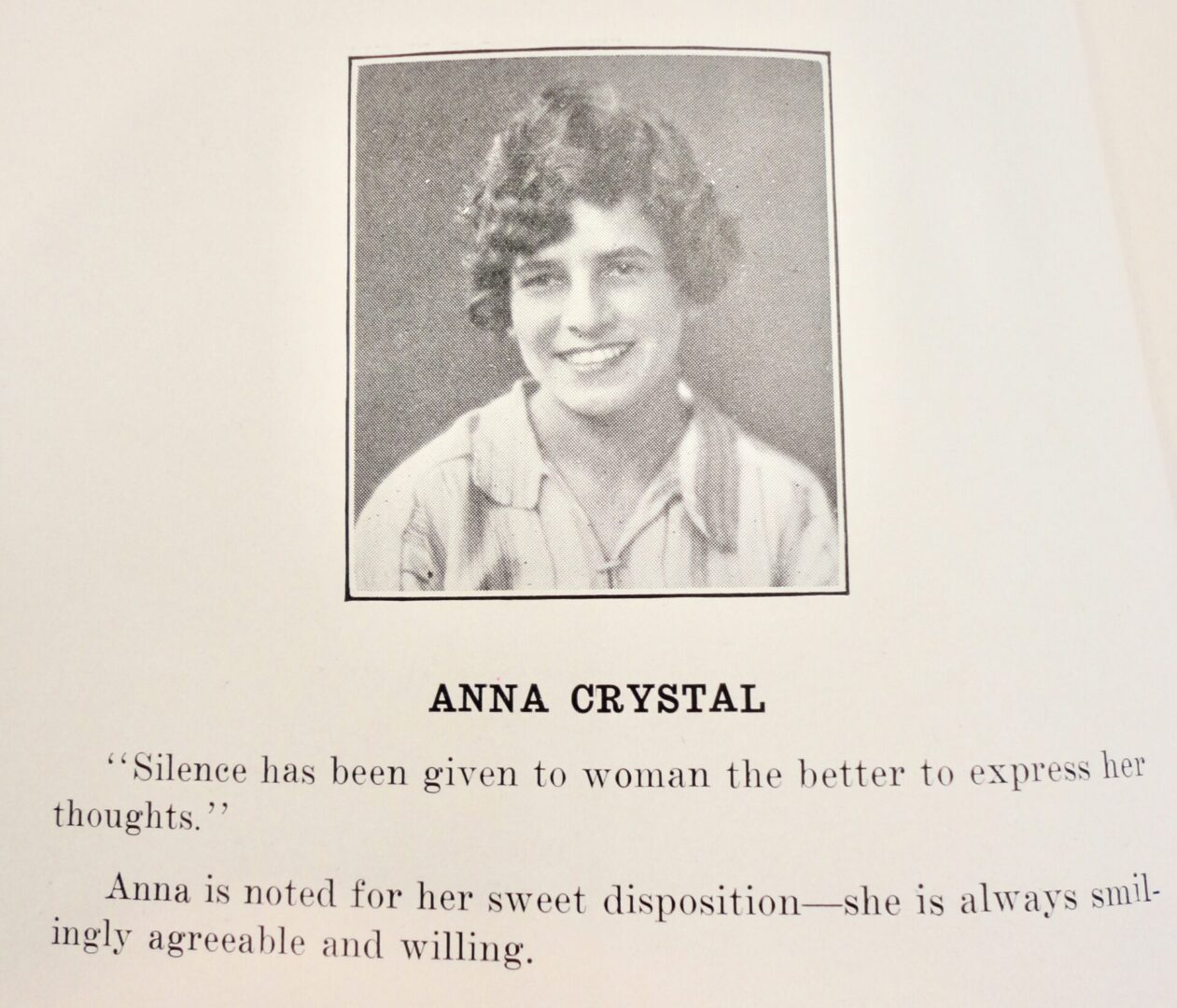Crystal Sisters: Anne, Rachel (Ray), Ida (Cryss), & Hilda
Lithuanian natives Sam Crystal and his wife, the former Mollie Rose Kaplan, were living in Oklahoma City with their six daughters when Mollie died of pneumonia in February 1918. Family members report that Mollie fell ill after helping save a neighbor’s cows and horses when an electrical storm set the barn on fire. Sam moved with his daughters to Chattanooga, Tennessee where he had relatives and opened a grocery store.

Mollie Rose Crystal was buried in Oklahoma City, Oklahoma. From Find A Grave.
For two years, Sam struggled to care for his girls. Despite his “brave efforts,” as B’nai B’rith’s Chattanooga Lodge wrote to the Home’s board, “the father and children all live in one little room in the back of his store,” and he was barely able to make a living. Because his relatives had their own family and were unable to look after Sam’s children, the Lodge urged that admitting the children to the Home in this “most pitiful case…would be a God send to Humanity.” The Home’s board admitted the four younger girls: Anne (11), Rachel (8), Ida (6), and Hilda (2). Older sisters Jean and Tabbie remained with their father.
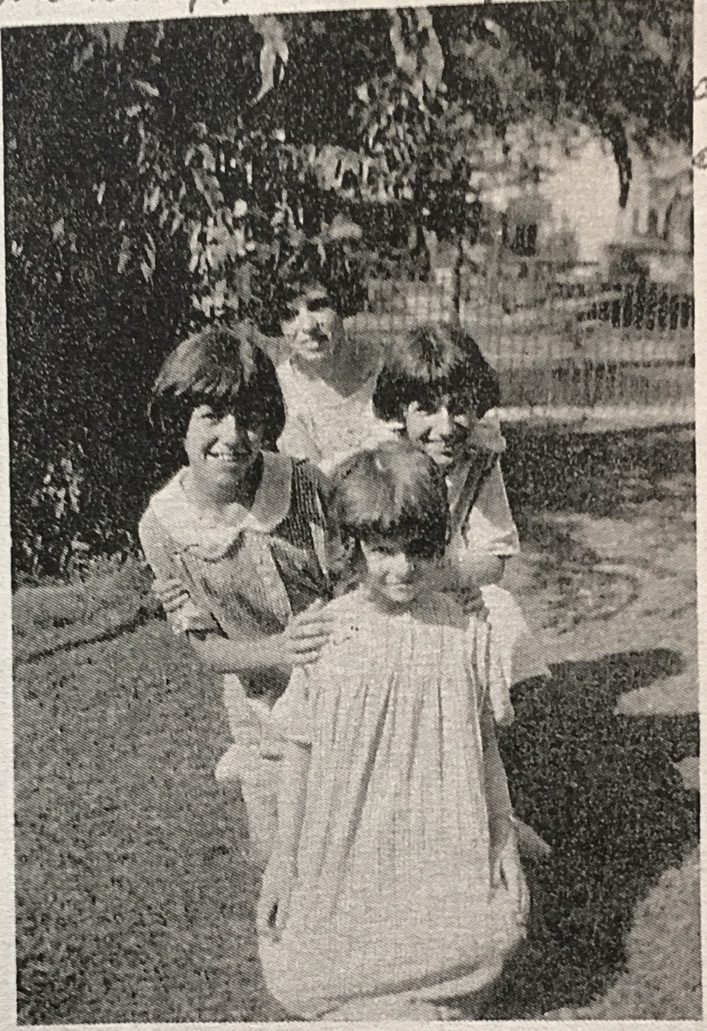
The Crystal sisters in the Home, 1925, clockwise from left, Ida, Anne, Rachel, and Hilda. Courtesy of Mika Singer, Rachel’s daughter.

Sam Crystal holding Hilda in the Home’s front yard. Courtesy of Mika Singer, Rachel’s daughter.
While in the Home, the girls attended Newman School and participated in Home activities, while keeping in contact with their father and sisters who occasionally came to visit. Hilda years later described how in 1926, during one visit, Tabbie brought her four younger sisters new outfits (including shoes and socks), which they wore to the (silent) movies to see John Gilbert and Rene Adoree in the “The Big Parade,” a popular film about the First World War, before capturing the happy day in a photograph at a photo studio.
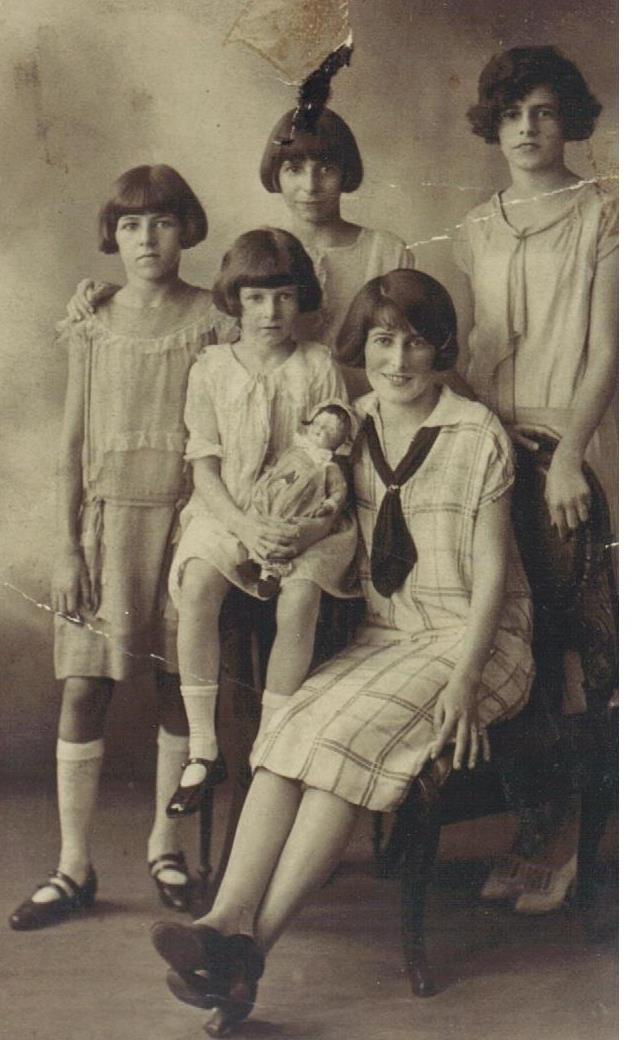
As Hilda later explained in a 1997 letter to her niece, the above photo was taken in a New Orleans photography studio during a 1926 visit to the Home by older sister Tabbie. Clockwise from left, Ida (Cryss), Rachel (Raye), Anne, Tabbie (in chair), Hilda (holding studio doll). Courtesy of Mika Singer, Rachel’s daughter.
In 1926, Anne (then called Anna) graduated from Newman School, where she had already made known her desire to become an artist. With the Home’s support, she enrolled in art courses at Newcomb College while continuing to live at the Home in a private room adjacent to the staff quarters. Superintendent Leon Volmer made this accommodation because he wanted to continue her “unusually fine influence upon her three sisters” and to “give her more intimate supervision and guidance, which a girl at this age so greatly needs.” She was fully discharged to her father in 1928 along with her sisters who finished their education in Chattanooga’s public schools.
She later continued her study of art with Lewis C. Daniel in New York City, and in Baltimore with Shelby Shackleford. Anne married Thomas Cook, a political science professor, with whom she relocated to El Paso, Texas. There she pursued her passion for painting, largely watercolors of nature, which she regularly exhibited. In 1970, her watercolor took first prize in a competition at the Chattanooga Museum of Art.
Anne died in 1981 at age 72 in El Paso, predeceased by her husband.
Ida (who was also known as Cryss) demonstrated a love of performing arts while still in the Home. In 1926, at age 12, as she wrote in the Home’s Golden City Messenger, she and Ida Rose Beerman organized the “Amateur Stars,” a group of ten girls who wanted to learn how to speak well before large audiences and “act out many little plays.” As she cautioned her readers and future audiences, “Sometimes you may not be able to recognize us in our costumes [dressed as fathers, mothers, children and animals], but our desire is that we will speak so loudly and distinctly that you will at once discover what we are.”
A few years after leaving the Home, Ida moved to New York City where, by her account, she studied modern dance with Martha Graham and theater at the Dramatic Workshop. She graduated in 1962, after 5 years of night school, from the Cooper Union for Science and Art where she majored in painting and sculpture. She also had a short stint on broadway and appeared in a 1951 episode of the television series, “The Big Story.”
In 1986, when she and her husband, Jacob Goldman, celebrated their 50th wedding anniversary, she wrote to JCRS Executive Director Viola Weiss, that she was happily reminded “of all the wonderful anniversaries we celebrated as children in the Home.”
Ida died at age 89 in 2003, just a few months before her husband.
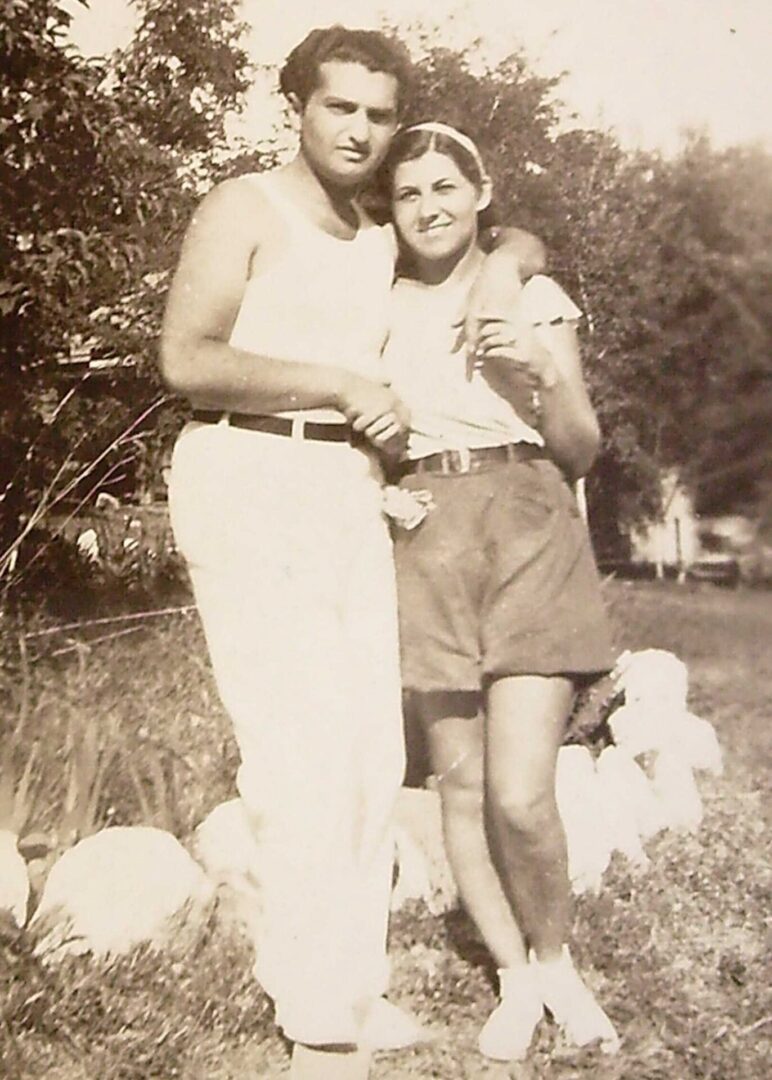
Undated photo of Ida “Cryss” Crystal and her husband Jacob “Yonnie” Goldman. From Ancestry.com.
By 1940, Rachel (known as Ray) was living in New York with her father and sisters. Later that year she married Morris Singer, a Juilliard trained pianist who by 1950 was working as what the census recorded as “a car greaser” for an automobile retailer. Ray and Morris had two daughters and later moved to Eugene, Oregon. Ray died in 2015.

After leaving the Home and Isidore Newman School in 1928, Ida, Ray, and Hilda finished their education in Chattanooga, Tennessee. Senior yearbook photos of Ida and Ray, Central High School, 1930. From Ancestry.com.
Hilda, the youngest sister, lived in the Home from ages 2 to 11. Unlike her sisters, she later wrote that she considered “every breathing moment” in the Home “a battle.” The only time she was happy was during annual trips to the Home’s summer camp on the Gulf Coast in Bay St. Louis, Mississippi. “Here, with a taste — a small taste of freedom,” wrote Hilda in her unpublished recollections, “my spirit was always quieted.” She would also later recall (by first name only) Edna, the Black woman whom she described as “my nurse and substitute mother in the Jewish Children’s Home.”
In 1936, Hilda graduated from Chattanooga High School, where her essay won first place in the state and second place in the nation, and also won her a job with IBM. Three years later, she married Warner Brown. After her marriage to Brown ended in divorce, Hilda married Arthur White, a political organizer and private music teacher, with whom she raised three daughters.
Hilda’s passion for writing continued. After several writing courses at Columbia University while raising her family, she published Wild Decembers (E.P. Dutton, 1957), a young adult fictional biography of the Bronte sisters. During a 1958 visit to New Orleans and the Home, Hilda explained to reporters that she chose the Bronte sisters, who were raised by their widowed father, “because their lives were so close to my family’s.” She also attributed the start of her writing career to her time in the Home, noting that the orphanage published a poem she wrote.
Hilda also authored Song Without End (E.P. Dutton, 1959), a novel based on the love story of pianist Clara Wiech and composer, Robert Schumann, as well as Truth is My Country (Doubleday, 1971), which profiled eight New England authors – Hawthorne, Emerson, Thoreau, Stowe, Dickinson, Robinson, Millay, and Frost. In addition to two volume of poetry, Hilda authored Notes to Thomas (Xlibris, 2002), a novel about the biographer of a fame-seeking poet.
Among Hilda’s papers, which she donated to the Howard Gottlieb Archival Research Center at Boston University, are photos and documents related to her time in the Home and at Newman School. Her papers also include an unpublished manuscript of her novel, Solange’s Boy (2003), which she set in 1926 in her beloved summer place and which bears the following dedication, “For my sisters, Anne, Rae and Cryss, in memory of summer months spent in Bay St. Louis, Mississippi in the 1920s.” Hilda died in 2011 in Berkeley, California.

Photo annotated by Hilda, August 1925 at the Home, in which she has her arm around “sweetheart,” Jacob Testa, and stands in front of other Home peers, Louis and Esther Berman, also from Chattanooga. Courtesy of Mika Singer, Rachel’s daughter and Hilda’s niece.
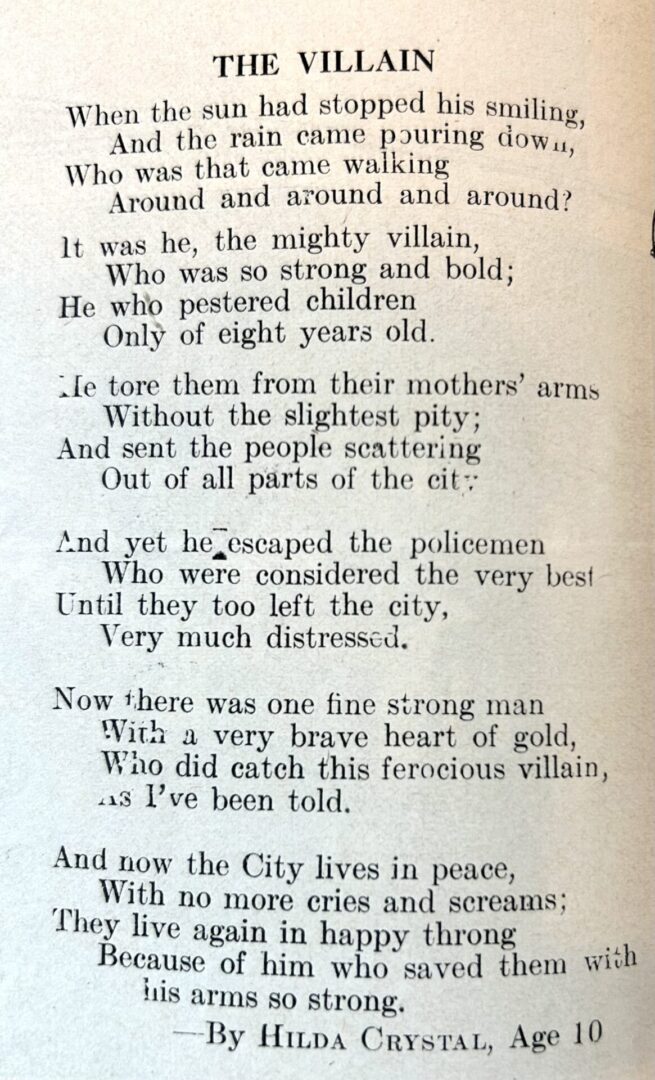
This poem by Hilda, which appeared in the Home’s April 1928 Golden City Messenger, is likely the poem to which she later attributed her start as a writer.
Hilda was not the only Crystal sister for whom the Home inspired a literary career. Older sister Jean Crystal Stanley, who did not live in the Home, wrote children’s books, including Horse With a One Track Mind (Westminster Press, 1962) which tells the story of a boy who, after his discharge from an orphanage, trains a trotting mare.

